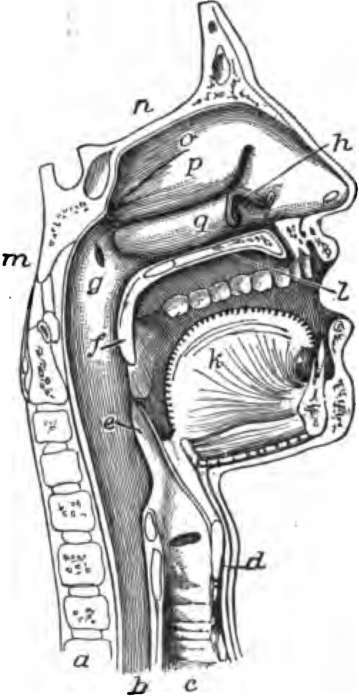The Pharynx Or Throat Cavity (Fig. 41)
Description
This section is from the book "The Human Body: An Elementary Text-Book Of Anatomy, Physiology, And Hygiene", by H. Newell Martin. Also available from Amazon: The Human Body.
The Pharynx Or Throat Cavity (Fig. 41)
This portion of the alimentary canal may be described as a conical bag with its broad end turned towards the base of the skull and its other end turned downwards and narrowing into the gullet. Its front or ventral wall is imperfect, presenting apertures which lead into the nose, the mouth, and (through the larynx and windpipe) into the lungs. Except when food is being swallowed the soft palate hangs down between the mouth and pharynx; during deglutition it is raised into a horizontal position, and separates an upper or respiratory portion of the pharynx from the rest. Through this upper part air alone passes,* entering it from the posterior ends of the two nostril chambers, while through the lower portion both food and air pass, one on its way to the gullet, b, Fig. 41; the other through the larynx, d, to the windpipe, c; when a morsel of food " goes the wrong way" it takes the latter course. Opening into the upper portion of the pharynx on each side is an Eustachian tube, g. At the root of the tongue, over the opening of the larynx, is a plate of cartilage, the epiglottis, e, which can be seen if the mouth is widely opened and the back of the tongue pressed down by some such thing as the handle of a spoon. During swallowing the epiglottis is pressed down like a lid over the opening of the air-tube and helps to keep food from entering it. The pharynx is lined by mucous membrane and has muscles in its walls which, by their contractions, drive the food on.

Where do the sublingual glands lie?
What is meant by the fauces? How are they bounded? What are the pillars of the fauces? What is a tonsil?
Why is temporary deafness not uncommon when we have a sore throat? What is usually done when the tonsils are permanently enlarged?
Briefly describe the pharynx.
* Observe for yourself with the help of a looking glass.
Continue to:
